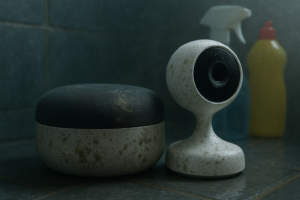Mold growth in your home is more than an unpleasant sight, it’s a health hazard to your family, especially to those who are sensitive to it. Learning how to prevent moldy appliances can prevent mold exposure symptoms from mild irritations to severe respiratory and other health problems.
Mold thrives in damp conditions and can grow in the tiniest places within the recesses of the major appliances in your home. It is attracted to moisture and can grow inside your refrigerator, dishwasher, or washing machine without realizing it.
While it may seem counterintuitive to clean the machines that clean other items in your home, regular inspection and thorough cleaning of those appliances can prevent the spread of dangerous mold spores.
Washing Machine
Your laundry room presents ideal conditions for mold growth if it is not adequately ventilated or left unattended. Moisture and dirt create breeding grounds for mold. Dirty piles of laundry in a warm, damp environment are the perfect home for mold to grow and prosper.
Mold growth on washing machines is easy to identify. Front-loading washers may see mold forming in the door creases or the detergent dispenser and top-loading washing machines are more likely to grow mold in the drum or interior walls.
Some common ways to prevent mold from forming in your washing machine include:
Running Loads Regularly
Damp clothes left in the laundry room, hampers, or strewn across a teenager’s bedroom floor will provide the perfect conditions for mold to grow and increase the chance of mold growth in your washing machine.
Drying Clothes After Washing
Wet clothes left in the washing machine can grow mold in no time. If you can’t get back to the washer for an extended period, it’s better to wait until you return to run the load rather than let the clean clothes sit wet in the washer.
Leaving the Lid Open After Use
Closing the washing machine lid after running a load will slow down the drying process and increase the chances of mold growth appearing before subsequent use.
Regular Cleaning
Perform monthly inspections on the door creases, drum, and detergent dispensers. Clean out the grime build-up that can be attractive to mold growth. Check the manufacturer’s manual for tips on keeping your washing machine clean.
Dishwasher
Your dishwasher is another appliance that can become a natural breeding ground for mold. Food particles left behind in warm, damp conditions will attract mildew and mold, and left unattended, can create significant problems for the dishwasher and your family.
Dishwashers have many folds, creases, compartments, and corners where moisture and gunk gather to form ideal moldy areas. Some ways to prevent mold growth in your dishwasher include:
Rinsing Dishes Before Loading the Dishwasher
It may be tempting to place dirty dishes in the dishwasher and let the appliance do all the work, but the problem comes when food chunks get lodged in hidden areas throughout the dishwasher. Food particles will remain in the machine and lead to mold growth over time.
Opening the Door
When the cycle is complete and after you put the dishes away, leaving the door open for a while will help dry out problem areas quicker. This eliminates excess moisture that can result in mold growth.
Running Heat Dry Cycles
Running your dishwasher on the heat-dry cycle will serve to kill bacteria and mold spores on the inside.
Drying Removable Baskets
Take out, clean, and dry the silverware baskets and other removable compartments with places that hide food particles.
Refrigerator
The inside of your refrigerator may not be the most dangerous area for mold growth in your home, but leftover food or spilled liquids present ideal conditions for mold to grow.
Keeping your refrigerator clean and clearing out old food before it has a chance to become moldy are the best ways to prevent mold growth in your fridge. Still, it takes more than wiping down the shelves periodically to keep your refrigerator clean and mold-free.
Cleaning Up Spills
You shouldn’t cry over spilled milk, but you should clean it up thoroughly if spilled in your fridge. Allowing spilled liquids to become stiff and crusty will invite moldy conditions.
Cleaning Trays and Drawers
The most effective way to prevent mold growth in your fridge is to periodically remove all trays, drawers, and compartments to give them a thorough cleaning. Use hydrogen peroxide or vinegar to ward off future mold growth.
Keeping It Dry
Make sure trays and shelves are kept as dry as possible. Wipe down areas of moisture before closing the fridge door.
Cleaning Behind Fridge Yearly
Condensation buildup under your refrigerator can lead to mold problems you can’t see. Moving your refrigerator and cleaning behind it will prevent mold growth over time.
Mold Removal Professionals
While it’s technically impossible to completely eliminate mold in your home, following these simple tips will prevent mold from growing in your major appliances.
Mold can still get out of hand despite your best efforts to prevent it. Leaky pipes can lead to significant mold growth that can only be remediated by professional mold removal experts.
Get Started With Us
Contact us today for complete information on our mold removal and water damage services.







